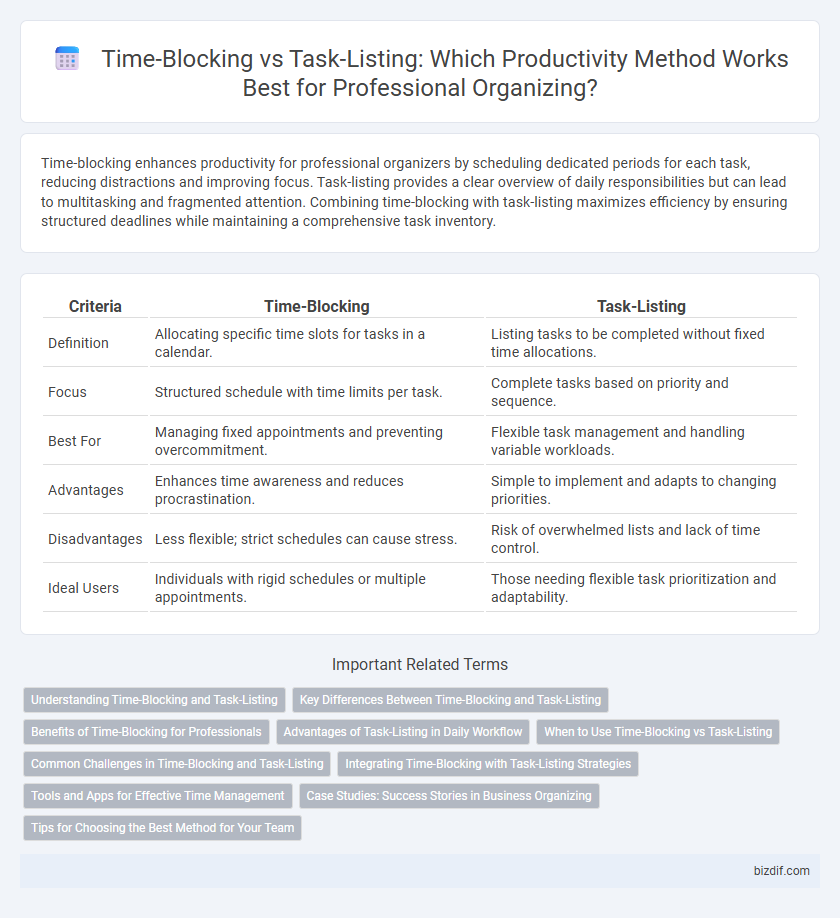Time-blocking enhances productivity for professional organizers by scheduling dedicated periods for each task, reducing distractions and improving focus. Task-listing provides a clear overview of daily responsibilities but can lead to multitasking and fragmented attention. Combining time-blocking with task-listing maximizes efficiency by ensuring structured deadlines while maintaining a comprehensive task inventory.
Table of Comparison
| Criteria | Time-Blocking | Task-Listing |
|---|---|---|
| Definition | Allocating specific time slots for tasks in a calendar. | Listing tasks to be completed without fixed time allocations. |
| Focus | Structured schedule with time limits per task. | Complete tasks based on priority and sequence. |
| Best For | Managing fixed appointments and preventing overcommitment. | Flexible task management and handling variable workloads. |
| Advantages | Enhances time awareness and reduces procrastination. | Simple to implement and adapts to changing priorities. |
| Disadvantages | Less flexible; strict schedules can cause stress. | Risk of overwhelmed lists and lack of time control. |
| Ideal Users | Individuals with rigid schedules or multiple appointments. | Those needing flexible task prioritization and adaptability. |
Understanding Time-Blocking and Task-Listing
Time-blocking allocates specific time segments for focused activities, enhancing productivity by minimizing distractions and improving time awareness. Task-listing involves creating prioritized lists of tasks, ensuring clear visibility of responsibilities and progress tracking. Both methods optimize workflow by aligning tasks with structured schedules or clear to-dos, catering to different organizational preferences.
Key Differences Between Time-Blocking and Task-Listing
Time-blocking segments the day into dedicated intervals focused on specific activities, enhancing concentration and reducing multitasking, while task-listing involves compiling a prioritized or sequential list of tasks without predefined time allocations. Time-blocking promotes structured productivity by assigning fixed durations to tasks, supporting better time estimation and deadline adherence, whereas task-listing offers flexibility but may lead to less efficient time management. The key difference lies in time-blocking's emphasis on scheduling blocks of time versus task-listing's focus on task prioritization without explicit time constraints.
Benefits of Time-Blocking for Professionals
Time-blocking enhances productivity by allocating specific periods for focused work, reducing distractions and multitasking. Professionals experience improved time management and greater accountability, ensuring high-priority tasks receive dedicated attention. This structured approach supports better work-life balance by clearly defining work intervals and breaks.
Advantages of Task-Listing in Daily Workflow
Task-listing enhances daily workflow by providing clear visibility of all tasks, enabling effective prioritization and preventing important activities from being overlooked. It allows for flexible adjustments throughout the day, accommodating unexpected changes without disrupting the overall plan. This method supports better focus and accountability by breaking down complex projects into manageable steps, improving productivity and time management.
When to Use Time-Blocking vs Task-Listing
Time-blocking is ideal for managing appointments, meetings, or tasks that require focused, uninterrupted periods, ensuring deep work and productivity during specific windows. Task-listing suits environments with fluctuating priorities, allowing flexibility to address urgent tasks as they arise and track smaller, diverse actions throughout the day. Using time-blocking maximizes efficiency for predictable schedules, while task-lists provide adaptability in dynamic workflows.
Common Challenges in Time-Blocking and Task-Listing
Time-blocking often struggles with inflexibility, making it difficult to adapt to unexpected tasks or interruptions, which can lead to schedule disruptions. Task-listing poses challenges such as prioritization difficulties and the risk of overwhelming workloads, as lengthy lists may cause procrastination or decrease focus. Both methods require consistent review and adjustment to improve productivity and accommodate changing work demands.
Integrating Time-Blocking with Task-Listing Strategies
Integrating time-blocking with task-listing strategies enhances productivity by combining structured scheduling with dynamic task prioritization. Time-blocking allocates specific time periods for focused work, while task-listing captures and organizes tasks by urgency and importance. This hybrid approach prevents overload, maximizes efficient use of work hours, and improves goal tracking and completion rates.
Tools and Apps for Effective Time Management
Time-blocking apps like Google Calendar and Microsoft Outlook excel in visualizing daily schedules, helping users allocate fixed time slots for focused work and reducing distractions. Task-listing tools such as Todoist and Trello specialize in prioritizing and tracking task completion, offering features like due dates, reminders, and project organization for enhanced productivity. Integrating both methods through platforms like Notion enables a comprehensive approach, combining time-blocking's structure with task-listing's flexibility to maximize effective time management.
Case Studies: Success Stories in Business Organizing
Case studies in business organizing reveal that time-blocking enhances focus by allocating specific periods for high-priority tasks, resulting in increased productivity and reduced overwhelm. In contrast, task-listing provides a comprehensive overview of daily responsibilities, helping professionals track progress and prioritize effectively. These success stories demonstrate tailored approaches, where combining time-blocking with task-listing optimizes organizational efficiency and boosts overall business performance.
Tips for Choosing the Best Method for Your Team
Time-blocking enhances team productivity by allocating specific time slots for focused work, reducing multitasking and improving deadline management. Task-listing offers flexibility by allowing team members to prioritize and address tasks based on urgency and available resources. Assess your team's workflow, project complexity, and individual work styles to determine if a structured schedule or a dynamic task list better supports your collective goals.
Time-blocking vs Task-listing Infographic

 bizdif.com
bizdif.com